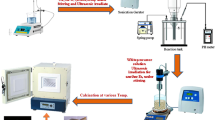Abstract
WE have prepared porous microstructures, having potential for prosthetic applications, consisting of hydroxapatite and of whitlockite, by employing exchange reactions at elevated temperatures and pressures. Rather demanding specifications are to be met by biomaterials being considered for tooth or bone replacement. Porous solids have the advantage of allowing circulation of body fluids and of increasing the potential for firm attachment of body tissue1,2. Weber et al.3 successfully replicated the porous structure of echinoid skeletal material in epoxy resin and in sodium silicate; and White et al.4 achieved replication of the coral Porites structure with methacrylate, tin, Tichonium, and sintered Al2O3. This was the starting point for our attempts to reproduce such structures in the phosphatic material which is a major component of human teeth and bones, hydroxyapatite. Such a material, porous, inorganic and sterile (formed at high temperatures and pressures), should be highly compatible with body tissue, and when used as bone implants may become essentially integral with the bone. Furthermore, composites of such porous hydroxyapatite with other materials including metals4 may achieve optimum mechanical and physical properties for a particular application.
Similar content being viewed by others
References
Klawitten, J. J., thesis, Clemson University, South Carolina (1970).
Hulbert, S. F., Klawitten, J. J., Sauer, B. W., and Matthews, J. R., Tech. Rept. No. 2, ONR, N00014-71-A-0339-001 (Proj. No. NR032-529), May 1, 1972.
Weber, J. N., White, E. W., and Lebiedzik, J., Nature, 233, 337 (1971).
White, R. L., Weber, J. N., and White, E. W., Science, N.Y., 176, 922 (1972).
Roy, R., and Tuttle, O. F., Physics and Chemistry of the Earth, 1, 138 (Pergamon, London, 1956).
Weber, J. N., Magnesium in Echinoderm Calcite, M.R.L. Monograph No. 4, 83 (1969).
Weber, J., Greer, R., Voight, B., White, E. W., and Roy, R., J. Ultrastruct. Res., 26, 355 (1969).
Nadel, M., Trombe, J. C., Bonel, G., and Montel, G., J. Chim. phys., 67, 1161 (1970).
Eysel, W., and Roy, D. M., Am. Assn Cryst. Growth, 65, July 1972 Program.
Eysel, W., and Roy, D. M., J. Cryst. Growth, 20, 245 (1973).
Roy, D. M., Mat. Res. Bull., 6, 1337 (1971).
Roy, D. M., and Roy, R., Structural Properties of Hydroxyapatite and Related Compounds, chap. 16 (edit. by Brown, W. E., and Young, R. A.) (Gordon and Breach, New York) (in the press).
Dickens, B., Bowen, J. S., and Brown, W. E., Abst. No. 676, IADR Meeting, Chicago, Ill., March, 1971.
Naray-Szabo, S., Zeit. Kristallogr. Kristall geom., 385 (1930).
Gron, P., van Campen, G. J., and Lindstrom, I., Archs oral Biol., 12, 829 (1967).
Dickens, B., Structural Properties of Hydroxyapatite and Related Compounds (edit. by Brown, W. E., and Young, R. A), chap. 21 (Gordon and Breach, New York) (in the press).
Calvo, C., and Gopal, R., Paper K-4, ACA Summer Meeting, Carleton University, Ottawa, Canada Aug. 1970.
Gopal, R., and Calvo, C., Nature phys. Sci., 237, 30 (1972).
Young, R. A., Sudarsaran, K., and Mackie, P. E., Bull. Soc. chim. Fr., 1760 (1968).
Author information
Authors and Affiliations
Rights and permissions
About this article
Cite this article
ROY, D., LINNEHAN, S. Hydroxyapatite formed from Coral Skeletal Carbonate by Hydrothermal Exchange. Nature 247, 220–222 (1974). https://doi.org/10.1038/247220a0
Received:
Issue Date:
DOI: https://doi.org/10.1038/247220a0
- Springer Nature Limited
This article is cited by
-
Temperature, pressure, and duration impacts on the optimal stiffening of carbonates aged in diammonium phosphate solution
Scientific Reports (2024)
-
Fabrication and characterization of 3D-printed composite scaffolds of coral-derived hydroxyapatite nanoparticles/polycaprolactone/gelatin carrying doxorubicin for bone tissue engineering
Journal of Materials Science: Materials in Medicine (2024)
-
Effect of heating temperature and time of hydrothermal reaction on the synthesis of hydroxyapatite from hen's eggshell
Journal of the Australian Ceramic Society (2023)
-
Effect of reaction time on the phase quantity of hydroxyapatite synthesized from Indian clam seashell by hydrothermal technique
Journal of the Australian Ceramic Society (2023)
-
Aesthetic Enhancement of the Brow using Hydroxyapatite
Aesthetic Plastic Surgery (2022)





